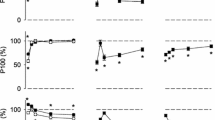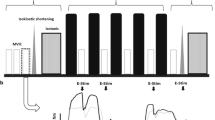Abstract
Indices of human skeletal muscle contractile function were examined in nine subjects for up to 9 days following a single bout of stimulated eccentric exercise. Eccentric muscle actions of the knee extensor muscles were evoked by percutaneous electrical myostimulation (PES). Delayed onset muscle soreness (DOMS), elevated serum creatine kinase activity, chronic force loss, and a decline in the 20: 100 Hz force ratio were observed in the days postexercise. The exercised knee extensor muscles demonstrated an impaired ability to respond to PES. This was evident by an increased time delay between the start of 100 Hz PES and the onset of contraction immediately postexercise [22.3 (SD 15.9)%, P < 0.01] and 3 days postexercise [14.9 (SD 18.1)%, P < 0.05]. Muscle relaxation rates appeared unaffected by the eccentric exercise protocol, where the muscles showed no differences in the time between the end of PES and the onset of relaxation (P > 0.05). During the days following the exercise, no significant differences were observed in the time between the start of contraction and attainment of 70% of the mean tetanic force following a single 1-s pulse of PES. Similarly, no significant differences were observed in the time between the start of relaxation and attainment of 70% of the total relaxation during the same time. The increased delay in excitation-contraction coupling observed immediately postexercise and 3 days after the exercise, may reflect a damage-induced delay in action potential propagation. Muscle relaxation rates postexercise remained unchanged, which would seem to indicate normal functioning of the sarcoplasmic reticulum, suggesting this was not the site of failure in excitation-contraction coupling.
Similar content being viewed by others
References
Armstrong RB (1984) Mechanisms of exercise-induced delayed onset muscular soreness: a brief review. Med Sci Sports Exerc 16:529–538
Broown SJ, Child RB, Donnelly AE, Saxton JM, Day SH (1995) Effects of stimulated eccentric exercise on indices of human muscle contractility. J Physiol 483:129 P
Byrd SK (1992) Alterations in the sarcoplasmic reticulum: a possible link to exercise-induced muscle damage. Med Sci Sports Exerc 24:531–536
Clarkson PM, Nosaka K, Braun B (1992) Muscle function after exercise induced muscle damage and rapid adaptation. Med Sci Sports Exerc 24:512–520
Crenshaw AG, Thornell L-E, Friden J (1994) Intramuscular pressure, torque and swelling for the exercise-induced sore vastus lateralis muscle. Acta Physiol Scand 152:265–267
Edwards RHT, Hill DK, Jones DA, Merton PA (1977) Fatigue of long duration in human skeletal muscle after exercise. J Physiol 272:769–778
Fitts RH (1994) Cellular mechanisms of muscle fatigue. Physiol Rev 4:49–94
Friden JM (1984) Changes in human skeletal muscle induced by long term eccentric exercise. Cell Tissue Res 236:365–372
Friden JM, Sjostrom M, Ekblom B (1983) Myofibrillar damage following intense eccentric exercise in man. Int J Sports Med 4:170–176
Jones DA (1981) Muscle fatigue due to changes beyond the neuromuscular junction. In: Porter R, Whelan J. (eds) Human muscle fatigue: physiological mechanisms. Pitman, London, pp178–196
Jones DA, Newham DJ, Round JM, Tolfree SE (1986) Experimental human muscle damage: morphological changes in relation to other indices of damage. J Physiol 375: 435–448
McCully KK, Faulkner JA (1985) Injury to skeletal muscle fibres of mice following lengthening contractions. J Appl Physiol 59:119–126
Newham DJ, Mills KR, Quigley BM, Edwards RHT (1983a) Pain and fatigue after concentric and eccentric muscle contractions. Clin Sci 64:55–62
Newham DJ, McPhail G, Mills KR, Edwards RHT (1983b) Ultrastructural changes after concentric and eccentric contractions of human muscle. J Neurol Sci 61:109–122
Newham DJ, Jones DA, Clarkson PM (1987) Repeated high force eccentric exercise: effects on muscle pain and damage. J Appl Physiol 63:1381–1386
Nosaka K, Clarkson RM, McGuiggin ME, Byrne JM (1991) Time course of muscle adaptation after high force eccentric exercise. Eur J Appl Physiol 63:70–76
Rodenburg JB, Bar PR, DeBoer RW (1993) Relations between muscle soreness and biochemical and functional outcomes of eccentric exercise. J Appl Physiol 74:2976–2983
Sacco P, McIntyre DB, Jones DA (1994) Effects of length and stimulation frequency on fatigue of the human tibialis anterior muscle. J Appl Physiol 77:1148–1154
Stauber WT (1989) Eccentric action of muscles. Physiology, injury and adaptation. In: Pandolf KB (ed) Exercise and sport science reviews, vol. 17. Williams and Wilkins, Baltimore, pp 157–185
Tiidus P, Ianuzzo C (1983) Effects of intensity and duration of muscular exercise on delayed soreness and serum enzyme activities. Med Sci Sports Exerc 5:461–465
Westerblad H, Duty S, Allen DG (1993) Intracellular calcium concentration during low-frequency fatigue in isolated single fibres of mouse skeletal muscle. J Appl Physiol 75:382–388
Author information
Authors and Affiliations
Additional information
Parts of this study have already been presented during a conference as preliminary results (Brown et al. 1995)
Rights and permissions
About this article
Cite this article
Brown, S.J., Child, R.B., Donnelly, A.E. et al. Changes in human skeletal muscle contractile function following stimulated eccentric exercise. Eur J Appl Physiol 72, 515–521 (1996). https://doi.org/10.1007/BF00242284
Accepted:
Issue Date:
DOI: https://doi.org/10.1007/BF00242284




